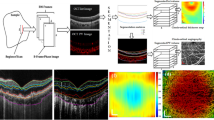Abstract
Purpose
Detection of eye diseases and their treatment is a key to reduce blindness, which impacts human daily needs like driving, reading, writing, etc. Several methods based on image processing have been used to monitor the presence of macular diseases. Optical coherence tomography (OCT) imaging is the most efficient technique used to observe eye diseases. This paper proposes an efficient algorithm to automatically classify normal as well as disease-affected (macular edema) retinal OCT images by using segmentation of Inner Limiting Membrane and the Choroid Layer.
Methods
In the proposed method, preprocessing of the input image is done to improve the quality and reduce the speckle noise. The layer segmentation is done on the gradient image, and graph theory and dynamic programming algorithm is performed. The feature vectors from segmented image are in terms of thickness profile and cyst fluid parameter, and these features are applied to various classifiers.
Results
The proposed method was tested with the standard dataset collected from the Department of Ophthalmology, Duke University, and achieved a high accuracy rate of 99.4975%, sensitivity of 100%, and specificity of 99% for the SVM classifier.
Conclusions
An efficient algorithm is proposed for macular edema detection from OCT images using segmentation based on graph theory and dynamic programming algorithm. The comparison with alternative methods yielded results that demonstrate the superiority of the proposed algorithm for macular edema detection.






Similar content being viewed by others
References
Hassan B, Raja G, Hassan T, Usman Akram M (2016) Structure tensor based automated detection of macular edema and central serous retinopathy using optical coherence tomography. J Opt Soc Am A: 33(4):455–463
Saine PJ (2006) Fundus photography: what is a fundus camera, 2nd edn. Ophthalmic Photographers Society, Boston
Cabrera Fernndez D, Salinas HM, Puliafito CA (2013) Central serous chorioretinopathy: update on pathophysiology and treatment. Surv Ophthalmol 58(2):103–126
Lee SY, Stetson PF, Ruiz-Garcia H, Heussen FM, Sadda SR (2012) Automated characterization of pigment epithelial detachment by optical coherence tomography. Investig Ophthalmol Vis Sci 53(1):164–170
Wilkins GR, Houghton OM, Oldenburg AL (2012) Automated segmentation of intra retinal cystoid fluid in optical coherence tomography. IEEE Trans Biomed Eng 59(4):1109–1114
Sahar S, Ayaz S, Akram MU, Basit I (2015) A case study approach iterative prototyping model based detection of macular edema in retinal OCT images. In: Proceedings of international conference on software engineering and knowledge engineering
Sugmk J, Kiattisin S, Leelasantitham A (2014) Automated classification between age-related macular degeneration and diabetic macular edema in OCT image using image segmentation. In: Proceedings of international conference on biomedical engineering
Srinivasan PP, Kim LA, Mettu PS, Cousins SW, Comer GM, Izatt JA, Farsiu S (2014) Fully automated detection of diabetic macular edema and dry age-related macular degeneration from optical coherence tomography images. Biomed Opt Express 5(10):3568–3577
Ferrara D, Mohler KJ, Waheed N, Adhi M, Liu JJ, Grulkowski I, Kraus MF, Baumal C, Hornegger J, Fujimoto JG, Duker JS (2013) En face enhanced-depth swept-source optical coherence tomography features of chronic central serous chorioretinopathy. Ophthalmology 121(3):719–726
Kondo T (2011) An image sequence segmentation method using gradient orientation information. In: Proceedings of SICE annual conference, pp 34–36
LaRocca F, Chiu SJ, McNabb RP, Kuo AN, Izatt JA, Farsiu S (2011) Robust automatic segmentation of corneal layer boundaries in SDOCT images using graph theory and dynamic programming. Biomed Opt Express 2(6):1524–1538
Canny J (1986) A computational approach to edge detection. IEEE Trans Pattern Anal Mach Intell 8(6):679–698
Kotsiantis SB (2007) Supervised machine learning: a review of classification techniques. In: Proceedings of the conference on emerging artificial intelligence applications in computer engineering: real word AI systems with applications in eHealth, HCI, information retrieval and pervasive technologies, pp 3–24
Srivastava S (2014) Weka: a tool for data preprocessing, classification, ensemble, clustering and association rule mining. Int J Comput Appl 88(10):0975–8887
Weis M, Rumpf T, Gerhards R, Plmer L (2009) Comparison of different classification algorithms for weed detection from images based on shape parameters. In: Manuela Zude H (ed) Bornimer Agrartechnische Berichte, vol 69. ATB, Potsdam, pp 53–64
Kamavisdar P, Saluja S, Agrawal S (2013) A survey on image classification approaches and techniques. Int J Adv Res Comput Commun Eng 2(1):1005–1009
Garvin MK, Abramoff MD, Wu X, Russell SR, Burns TL, Sonka M (2009) Automated 3-D intraretinal layer segmentation of macular spectral-domain optical coherence tomography images. IEEE Trans Med Imaging 28(9):1436–1447
Lee K, Niemeijer M, Garvin MK, Kwon YH, Sonka M, Abramoff MD (2010) Segmentation of the optic disc in 3-D OCT scans of the optic nerve head. IEEE Trans Med Imaging 29(1):159–168
Funding
This study was funded by APJ Abdul Kalam Technological University (APJAKTU)–Centre for Engineering Research and Development (CERD), India (Grant No. KTU/RESEARCH 2/56/2017 dated 06-01-2017).
Author information
Authors and Affiliations
Corresponding author
Ethics declarations
Conflict of interest
The authors declare that they have no conflict of interest.
Ethical Approval
For this type of study, formal consent is not required.
Informed Consent
This article does not contain any studies with human participants or animals performed by any of the authors.
Rights and permissions
About this article
Cite this article
Jemshi, K.M., Gopi, V.P. & Issac Niwas, S. Development of an efficient algorithm for the detection of macular edema from optical coherence tomography images. Int J CARS 13, 1369–1377 (2018). https://doi.org/10.1007/s11548-018-1795-6
Received:
Accepted:
Published:
Issue Date:
DOI: https://doi.org/10.1007/s11548-018-1795-6




